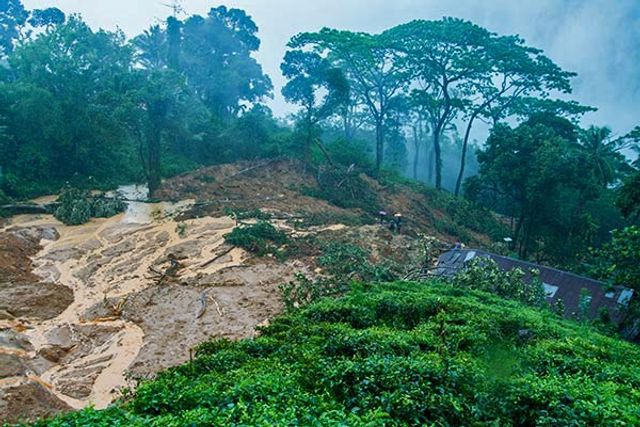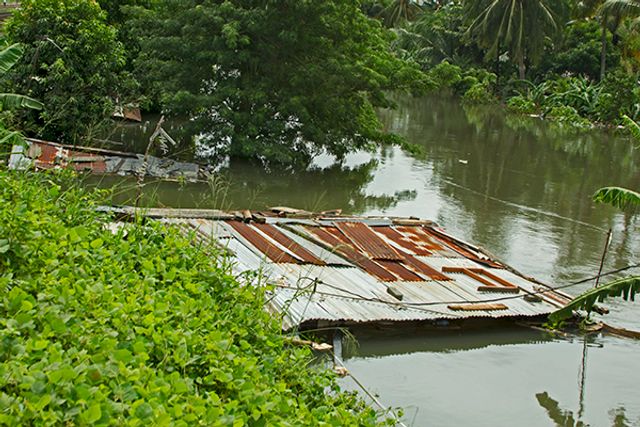Pani Wijesiriwardena
Tens of thousands remain homeless in Sri Lanka, while the number of people killed from Cyclone Roanu continues to rise. According to the Disaster Management Centre’s latest report, 101 people are confirmed dead in flooding and landslides. Rescue operations continue at Aranayake, where three villages were buried in a catastrophic landslide last week. Only 23 bodies have been found, out of the 134 people believed to be buried under tonnes of mud in these villages.
 Landslide at Kalupahana Estate
Landslide at Kalupahana Estate
In Colombo, over 200,000 of the city’s 650,000 residents have been displaced by major flooding. Thousands are accommodated in so-called welfare centres at temples and schools, in roadside tents or under the bridges of elevated roads.
Sri Lankan authorities report that over 125,000 homes and more than 300,000 small and medium businesses have been destroyed or damaged by landslides and floods. The finance ministry estimates that the total damage will be between $US1.5 billion and $US2 billion.
Torrential rains associated with Cyclone Roanu also hit Bangladesh last Saturday where an estimated 2 million people have been forced to leave their homes and at least 23 people have been killed.
Apart from perfunctory warnings for the public to be “vigilant,” the Sri Lankan government took no serious measures to counteract the danger of floods and landslides caused by Cyclone Roanu. This was despite consistent scientific predictions of extreme storm events precipitated by the current El Nino period. No evacuation crews or rapid response teams were deployed to potential disaster areas and no emergency shelters established in advance.
Sri Lanka’s disaster preparedness and management is virtually non-existent, despite the passage of the Disaster Management Act in 2005 and the establishment of the Disaster Management Centre (DMC). This toothless institution was introduced in response to deep public anger over the inadequacy of the government’s response to the Indian Ocean tsunami in late 2004 and the so-called recovery process.
In the more than decade of its existence, the DMC has not even established a proper dedicated rapid-response team with search and rescue capacity. This is in a country where deadly landslides occur every year. Military personnel deployed for search operations have been using their bare hands and long sticks.
 Kajeemawatta shanty town in Colombo city
Kajeemawatta shanty town in Colombo city
On Monday, President Maithripala Sirisena declared that landslide-affected areas should be defined as High Security Zones and action taken to stop the construction of houses in “unsuitable places for living” and to prevent “unauthorised reclamation.”
Media reports said the government would deploy military and police units to prevent such “encroachments.” This unexplained move will be used to prevent poor families from settling in urban areas and to speed up the government eviction of shanty dwellers in order to release land for its Megalopolis project.
Yesterday, the government’s National Building Research Organisation announced that around 2,800 families will not be allowed to resettle in their original communities. This includes hundreds of homeless families in Aranayake. The government has not said whether the displaced families will be given alternative dwellings.
Aranayake residents told the WSWS that displaced villagers were being accommodated in dozens of “welfare centres” without adequate food and other assistance, and voiced their concerns about the future.
 The roofs of small wooden houses at Orugodawath
The roofs of small wooden houses at Orugodawath
Tens of thousands of working class and poor families were abandoned by Sri Lankan authorities following the 2004 tsunami. In Colombo, the previous government of President Mahinda Rajapakse spent billions of rupees for the beautification of the city, but slum dwellers and the poor were forced into unsafe, makeshift camps and left to experience yet another disaster.
The Sirisena-Wickremesinghe government has boasted of large donations from various foreign governments. The US has again shown its hypocrisy. Washington’s envoy to Sri Lanka, Atul Keshap, announced that the US has allocated $50,000 (7.2 million rupees) for flood relief in Sri Lanka. This is from a country which spends billions of dollars for wars to establish its global hegemony.
The Cyclone Roanu disaster has again revealed that the ruling elite and its successive governments, whether led by the United National Party or the Sri Lanka Freedom Party, are unwilling and incapable of providing the most rudimentary safety to residents.
In the past few days, the media has featured President Sirisena, Prime Minister Ranil Wickremesinghe and other ministers visiting flood and landslide victims in shelters and camp, feigning concern and making various pledges. Their promises will come to nothing.
Following the 2004 tsunami, the WSWS commented: “Confronting the greatest disaster to have hit the country in centuries, the entire political establishment is appealing for ‘unity’. Various appeals for aid have been made. Statements of sympathy have been issued. But their primary aim is to cover up the gross negligence of governments—both present and past—and to deflect growing anger over the level of assistance and relief being provided.”
This analysis has again been confirmed in the latest catastrophe.
No comments:
Post a Comment